8.16.2023
The Cultural History of Godzilla – Pt 60
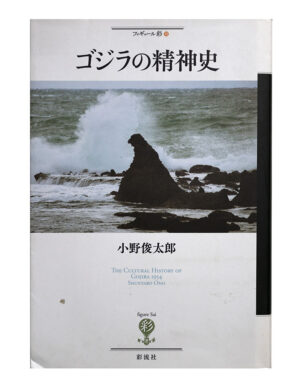
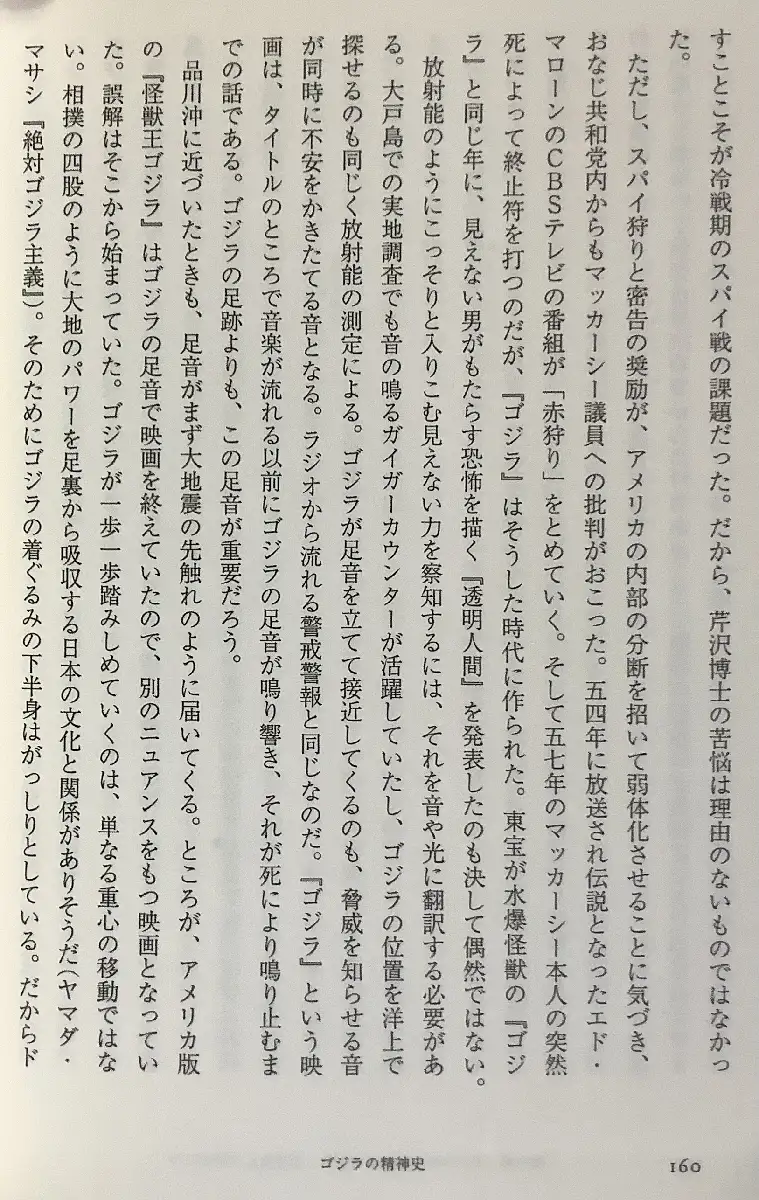
P 160
だから、芹沢博士の苦悩は理由のないものではなかった。
Therefore, Dr. Serizawa’s anguish was not without reason.
ただし、スパイ狩りと密告の奨励が、アメリカの内部の分断を招いて弱体化させることに気づき、おなじ共和党内からもマッカーシー議員への批判がおこった。五四年に放送され伝説となったエド・マローンのCBSテレビの番組が「赤狩り」をとめていく。そして五七年のマッカーシー本人の突然死によって終止符を打つのだが、『ゴジラ』はそうした時代に作られた。東宝が水爆怪獣の『ゴジラ』と同じ年に、見えない男がもたらす恐怖を描く「透明人間」を発表したのも決して偶然ではない。放射能のようにこっそりと入りこむ見えない力を察知するには、それを音や光に翻訳する必要がある。大戸島での実地調査でも音の鳴るガイガーカウンターが活躍していたし、ゴジラの位置を洋上で探せるのも同じく放射能の測定による。ゴジラが足音を立てて接近してくるのも、脅威を知らせる音が同時に不安をかきたてる音となる。ラジオから流れる警戒警報と同じなのだ。『ゴジラ』という映画は、タイトルのところで音楽が流れる以前にゴジラの足音が鳴り響き、それが死により鳴り止むまでの話である。ゴジラの足跡よりも、この足音が重要だろう。
However, criticism of Senator McCarthy also came from within the Republican Party, realizing that the encouragement of spy-hunting and informants would divide and weaken America’s interior. Ed Malone’s legendary CBS television program broadcast in 1954 stopped “Red Scare.” And the sudden death of McCarthy himself in 1957 put an end to it, but “Godzilla” was made in such an era. It’s no coincidence that Toho released “Invisible Man,” which depicts the terror of an invisible man, in the same year as the hydrogen bomb monster “Godzilla.” In order to perceive an invisible force that creeps in like radioactivity, it is necessary to translate it into sound and light. A Geiger counter that makes a sound was used in field research on Odo Island, and radioactivity measurement is also used to locate Godzilla on the ocean. The sound of Godzilla approaching with his footsteps is also a sound that informs us of the threat and at the same time stirs up anxiety. It’s the same as the warnings you hear on the radio. The movie “Godzilla” tells the story of Godzilla’s footsteps resounding before the music plays at the title, until death stops them. These footsteps are more important than Godzilla’s footprints.
品川沖に近づいたときも、足音がまず大地震の先触れのように届いてくる。ところが、アメリカ版の『怪獣王ゴジラ」はゴジラの足音で映画を終えていたので、別のニュアンスをもつ映画となっていた。誤解はそこから始まっていた。ゴジラが一歩一歩踏みしめていくのは、単なる重心の移動ではない。相撲の四股のように大地のパワーを足裏から吸収する日本の文化と関係がありそうだ(ヤマダ・マサシ『絶対ゴジラ主義』)。そのためにゴジラの着ぐるみの下半身はがっしりとしている。だからドラゴンやイグアナではどうにも心許なくて困るのだ。
Even when approaching the coast of Shinagawa, footsteps are the first to arrive, like a harbinger of a major earthquake. However, the American version of “Godzilla, King of the Monsters” ended with the sound of Godzilla’s footsteps, so it was a movie with a different nuance. That’s where the misunderstanding started. Godzilla’s stepping step by step is not just a movement of the center of gravity. It seems to have something to do with the Japanese culture of absorbing the power of the earth through the soles of the feet, much like sumo wrestling’s four legs (Masashi Yamada, Absolute Godzilla Principle). For that reason, the lower body of Godzilla’s costume is solid. That’s why dragons and iguanas are so frustrating.
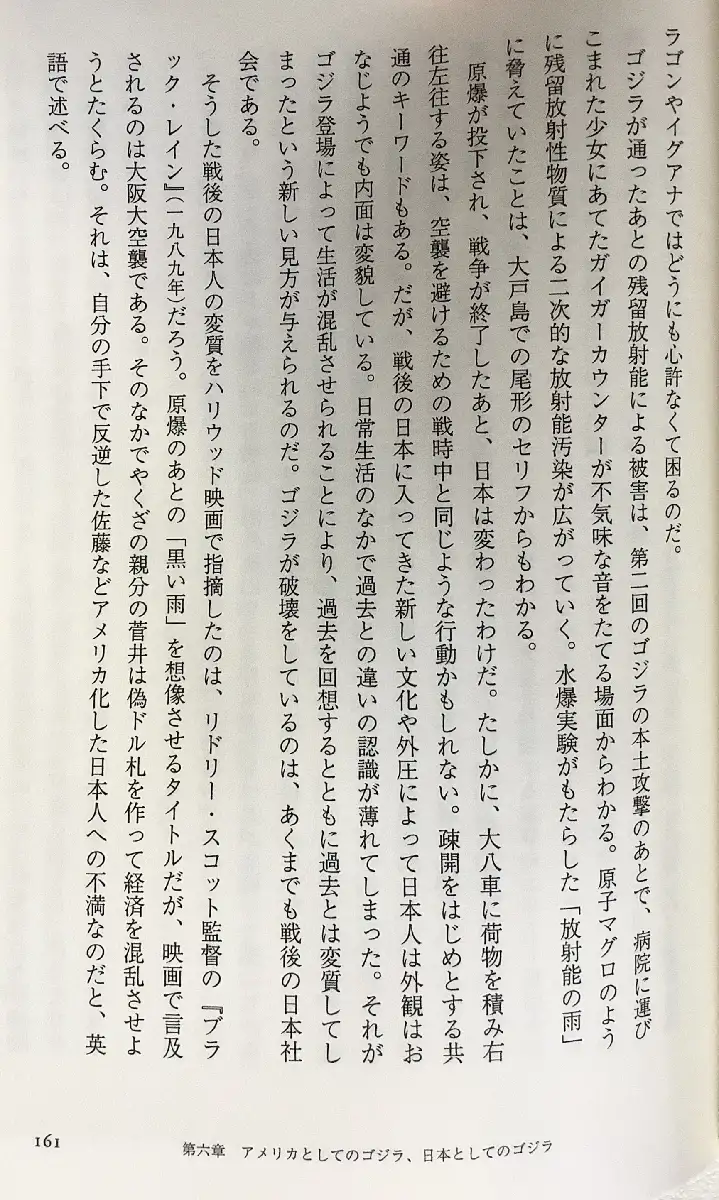
P 161
ゴジラが通ったあとの残留放射能による被害は、第二回のゴジラの本土攻撃のあとで、病院に運びこまれた少女にあてたガイガーカウンターが不気味な音をたてる場面からわかる。原子マグロのように残留放射性物質による二次的な放射能汚染が広がっていく。水爆実験がもたらした「放射能の雨」に脅えていたことは、大戸島での尾形のセリフからもわかる。
The damage caused by residual radioactivity after Godzilla’s passage can be seen from the scene where the Geiger counter that hits the girl who was brought to the hospital makes an eerie sound after Godzilla’s second attack on the mainland. Secondary radioactive contamination with residual radioactive materials like atomic tuna spreads. Ogata’s words on Odo Island show that he was frightened by the “radioactive rain” brought about by the hydrogen bomb test.
原爆が投下され、戦争が終了したあと、日本は変わったわけだ。たしかに、大八車に荷物を積み右往左往する姿は、空襲を避けるための戦時中と同じような行動かもしれない。疎開をはじめとする共通のキーワードもある。だが、戦後の日本に入ってきた新しい文化や外圧によって日本人は外観はおなじようでも内面は変貌している。日常生活のなかで過去との違いの認識が薄れてしまった。それがゴジラ登場によって生活が混乱させられることにより、過去を回想するとともに過去とは変質してしまったという新しい見方が与えられるのだ。ゴジラが破壊をしているのは、あくまでも戦後の日本社会である。
After the atomic bomb was dropped and the war ended, Japan changed. Certainly, the sight of people lazily running back and forth with their luggage loaded onto the large two-wheeled wagons may be the same behavior they did during wartime to avoid air raids. There are also common keywords such as evacuation. However, due to the new culture and external pressure that entered Japan after the war, the Japanese are transformed inside even if they look the same. In everyday life, the recognition of the difference from the past has faded. However, the appearance of Godzilla disrupts our lives, giving us a new way of looking back on the past and transforming it from the past. What Godzilla is destroying is Japanese society after the war.
そうした戦後の日本人の変質をハリウッド映画で指摘したのは、リドリー・スコット監督の『ブラック・レイン』(一九八九年)だろう。原爆のあとの「黒い雨」を想像させるタイトルだが、映画で言及されるのは大阪大空襲である。そのなかでやくざの親分の菅井は偽ドル札を作って経済を混乱させようとたくらむ。それは、自分の手下で反逆した佐藤などアメリカ化した日本人への不満なのだと、英語で述べる。
Ridley Scott’s “Black Rain” (1989) is a Hollywood movie that pointed out the transformation of the Japanese after the war. Although the title reminds us of the “black rain” after the atomic bombing, the movie refers to the Osaka air raid. Yakuza boss Sugai plots to create counterfeit dollar bills to disrupt the economy. He says in English that it is a dissatisfaction with Americanized Japanese people such as Sato, who rebelled against his subordinates.
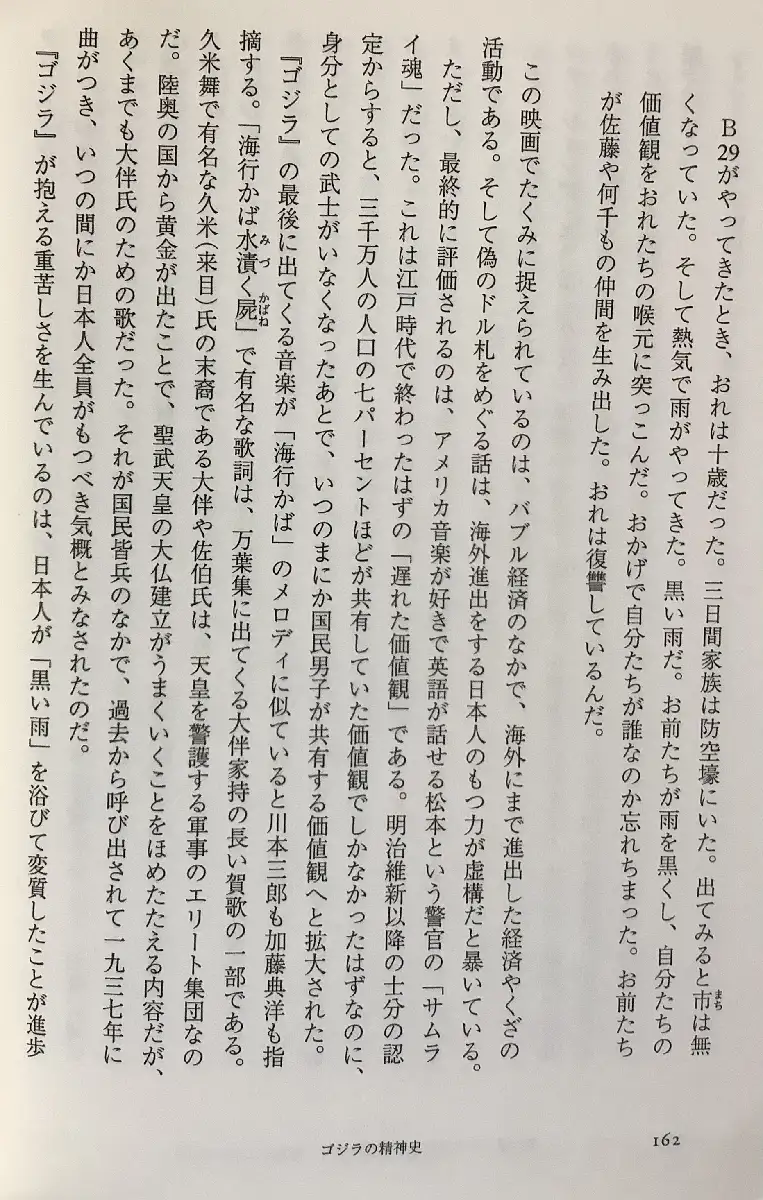
P 162
B2がやってきたとき、おれは十歳だった。三日間家族は防空壕にいた。出てみると市は無まちくなっていた。そして熱気で雨がやってきた。黒い雨だ。お前たちが雨を黒くし、自分たちの価値観をおれたちの喉元に突っこんだ。おかげで自分たちが誰なのか忘れちまった。お前たち佐藤や何千もの仲間を生み出した。おれは復讐しているんだ。
I was ten years old when B2 came along. For three days the family was in an air raid shelter. When I got out, the city was gone. Then came the heat and the rain. Black rain. You turned the rain black and put your values down our throats. We forgot who we were. You gave birth to Sato and thousands of friends. I’m taking revenge
この映画でたくみに捉えられているのは、バブル経済のなかで、海外にまで進出した経済やくざの活動である。そして偽のドル札をめぐる話は、海外進出をする日本人のもつ力が虚構だと暴いている。ただし、最終的に評価されるのは、アメリカ音楽が好きで英語が話せる松本という警官の「サムライ魂」だった。これは江戸時代で終わったはずの「遅れた価値観」である。明治維新以降の士分の認定からすると、三千万人の人口の七パーセントほどが共有していた価値観でしかなかったはずなのに、身分としての武士がいなくなったあとで、いつのまにか国民男子が共有する価値観へと拡大された。
What this film cleverly captures is the activities of the economic yakuza who have expanded overseas during the bubble economy. And the story of fake dollar bills exposes the power of the Japanese to expand overseas as fictional. However, in the end, what was evaluated was the “samurai spirit” of a police officer named Matsumoto, who liked American music and could speak English. This is a “delayed sense of values” that should have ended in the Edo period. Judging from the recognition of samurai rank after the Meiji Restoration, it should have been only a value shared by about 7% of the population of 30 million people, but after the samurai class disappeared, before we knew it it was shared by men of the nation. It was expanded to values to do.
『ゴジラ』の最後に出てくる音楽が「海行かば」のメロディに似ていると川本三郎も加藤典洋も指摘する。「海行かば水漬く屍」で有名な歌詞は、万葉集に出てくる大伴家持の長い賀歌の一部である。久米舞で有名な久米(来目)氏の末裔である大伴や佐伯氏は、天皇を警護する軍事のエリート集団なのだ。陸奥の国から黄金が出たことで、聖武天皇の大仏建立がうまくいくことをほめたたえる内容だが、あくまでも大伴氏のための歌だった。それが国民皆兵のなかで、過去から呼び出されて一九三七年に曲がつき、いつの間にか日本人全員がもつべき気概とみなされたのだ。
Both Saburo Kawamoto and Norihiro Kato point out that the music at the end of “Godzilla” resembles the melody of “Umiyukaba.” The famous lyric of “Umiyukaba Mizukuku corpse” is part of a long poem by Otomo no Yakamochi that appears in Manyoshu. The Otomo and Saeki clan, descendants of the Kume (Kume) clan, who are famous for their Kume dance, are an elite military group that protects the emperor. The content of the song is to praise the successful construction of the Great Buddha by Emperor Shomu, thanks to the supply of gold from Mutsu Province. In 1937, when the universal conscription was summoned from the past, it came to an end in 1937, and before we knew it, it was regarded as the spirit that all Japanese people should possess.
『ゴジラ』が抱える重苦しさを生んでいるのは、日本人が「黒い雨」を浴びて変質したことが進歩なのかという問いかけと、では過去を温存しておいて復古すればそれで解決するのかという悩みとが並存している点にある。
The somberness of “Godzilla” is caused by the question of whether the change in nature of the Japanese people under the “black rain” is progress. The problem is that it coexists.
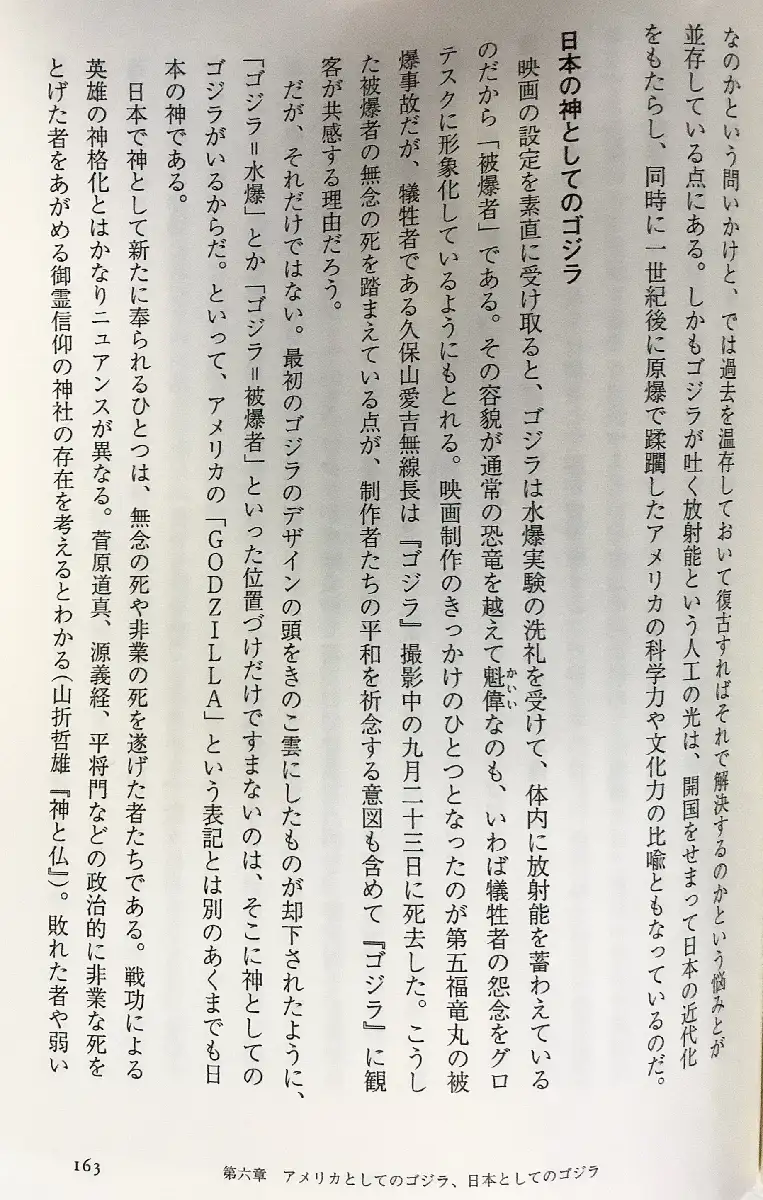
P 163
しかもゴジラが吐く放射能という人工の光は、開国をせまって日本の近代化をもたらし、同時に一世紀後に原爆で蹂躙したアメリカの科学力や文化力の比喩ともなっているのだ。
Moreover, the artificial light of radioactivity spewed out by Godzilla brought about the modernization of Japan by pressing for the opening of the country, and at the same time became a metaphor for the scientific and cultural power of America, which was overwhelmed by the atomic bomb a century later.